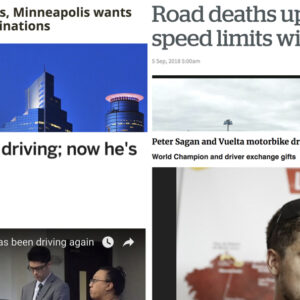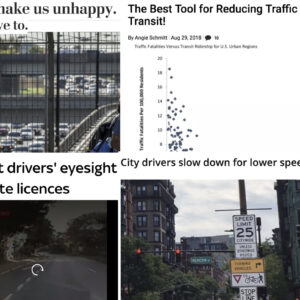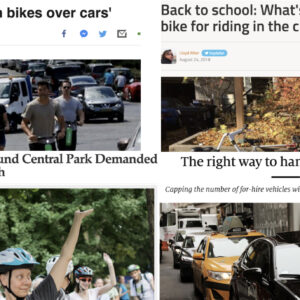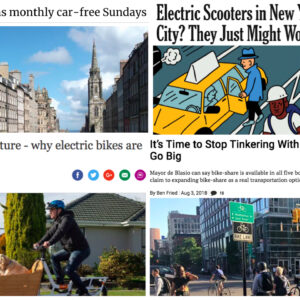Thank you!
This week’s Monday Roundup is brought to you by the Harvest Century coming September 23rd. It’s the last organized ride of the season, and with four route choices, there’s something for the entire family. Get 15% off registration when you use “BIKEPORTLAND18” code at checkout.
Here are the most noteworthy items we were introduced to in the past seven days…
Bike lobby strikes again: Framed around a project that looks a lot like Better Naito, advocates for better cycling in Baltimore have struck fear into the heart of Fortune magazine editor Rush Loving Jr.
JSK in Detroit: None other than lauded former NYC DOT Commish-turned-consultant Janette Sadik-Khan was in the Motor City last week to celebrate that city’s new transportation plan. And it’s really good.
Bike share sabotage: Someone cut brake cables on a Lime bike in Seattle and it led to an injury crash.
E-bikes and safety: I’ve been concerned about e-bike safety for years now and it seems my fears are warranted based on this story in The Guardian about a woman who was hit and killed by an e-bike rider in London.
Resiliency emergency: Another hurricane season, another reminder that our over-reliance on driving cars and trucks is making our cities more dangerous.
Advertisement
Universal Basic Mobility: Or UBM for short, is the transportation form of Universal Basic Income — says Alex Roy in this persuasive essay.
E-bike skeptic: Dutch cycling expert David Hembrow has attracted scorn for his take on a recent study he says proves, “Riding e-bikes does not lead to health benefits.”
Epic cover art: Check the fantastic illustration by Cecilia Granata on the cover of Microcosm’s latest book: Dragon Bike: Fantastical Stories of Bicycles, Feminism, & Dragons.
It worked for Vancouver (BC): France has announced a $410 million plan to boost cycling rates ahead of the 2024 Olympics.
Congestion not the bogeyman: Streetsblog reports on a new study from the Bay Area that shows people who live close-in where roads are more congested, still have better access to jobs than those who live in relatively traffic-free suburbs.
Fake helmets: Stoked you found such a great price on a new, brand-named lid? Better make sure it’s not a counterfeit.
Thanks to everyone who flagged stories for us this week!
— Jonathan Maus: (503) 706-8804, @jonathan_maus on Twitter and jonathan@bikeportland.org
Never miss a story. Sign-up for the daily BP Headlines email.
BikePortland needs your support.






Thanks for reading.
BikePortland has served this community with independent community journalism since 2005. We rely on subscriptions from readers like you to survive. Your financial support is vital in keeping this valuable resource alive and well.
Please subscribe today to strengthen and expand our work.
New census bike mode share statistics show a slight drop in bike mode share for 2017.
2017 census estimate (1 yr ACS) bike mode share: 6.3%
https://factfinder.census.gov/bkmk/table/1.0/en/ACS/17_1YR/S0802/1600000US4159000
2016 census estimate (5yr ACS) bike mode share: 6.5%
https://factfinder.census.gov/bkmk/table/1.0/en/ACS/16_5YR/S0801/1600000US4159000
wrong link for 2017:
https://factfinder.census.gov/bkmk/table/1.0/en/ACS/17_1YR/S0801/1600000US4159000
Am I missing something? Last I checked, 6.3% equals 6.3%. That’s not much of a drop. In fact, in eight of the past ten years, PDX has been stuck between 5.8-6.8%, with the other two years slightly above that range. Heck, driving is down slightly in 2017, but mostly because more people are working from home. Not anything to celebrate, but thing’s aren’t getting worse, at least.
Now if we want to look at declines, take a look at what’s going down in Eugene. From a high of 10.8% in 2009 cycling mode share has been steadily decreasing to the stunningly low 4.4% in the 2017 ACS. Ouch!
I guess the added buffers, two-way cycletrack sidepaths and plans for more of same aren’t working as hoped in Eugene. Perhaps the messaging these builds send about cycling where cars are present being dangerous is what’s getting through, with very predictable results.
yeah…i am comparing the 2017 1 yr estimates to the recently released 5 yr data for 2016 (it’s always a good idea to use better data).
Hurricanes and getting out.
The article goes some distance in this direction but hardly far enough. Why focus on leaving? Why not figure out, strategize how to provide safety where (or near where) people already are?
Secondly, the article suggests—and I’m not at all sure this is a good assumption—that a car is a ticket out. I thought that in the past we’ve seen massive traffic jams when everyone tries to flee via car.
In this last hurricane, of the 1.7 million who were ordered to evacuate, public officials say only about 400,000 actually did leave. Most stayed at home. While there were thousands of rescues, most residents were in fact fine, even in hard-hit Wilmington (now an island). Charleston SC was hardly hit at all.
Hurricanes are very unpredictable storms, a bit like cyclists at a new traffic circle. You never know exactly where they are going, for how long, nor where they will dump the most water. This latest storm hit an area with 14 million people. Nowhere in the US can handle that many people to be evacuated. So you are best served by getting people to adapt to their environment – build houses and apartments on slopes when available, on artificial hills, on stilts, or even within gated flood walls with sump pumps (for towns and cities) – which is exactly what most folks have done.
As an aside, we had 5 inches of rain last night here in Greensboro NC. Since we are at the top of a plateau, you can bet that’s going to cause a lot of flooding downstream.
It did talk about the local shelters they created for people that can’t get out.
You’ve been concerned about ” e-bike safety for years” and now after one death your fears are warranted?
I think the fatality rate for legos is significantly higher.
It’s a hunch JJJ. I spend my days listening to chatter about bike-related things and I can sense the chatter around this growing in the same direction as concerns I’ve held for a long time. The part in that article that jumped out at me (because I’ve said the exact words to people in conversation).. Is that the increased speeds attainable on an e-bike are risky for both the user — and perhaps more importantly — other road users because people are not used to bike riders of all types going 20mph.
All of our cyclist deaths here in Greensboro over the past 5 years have apparently been road riders on racing bikes going well over 20 mph in rural and semi-suburban areas. In most cases, I suspect bike speed had nothing to do with it, but rather drivers not looking out for anyone but themselves, if that.
To be honest, I’m rather surprised to see you defending car drivers who “are not used to bike riders of all types going 20 mph.” From my experience, most drivers aren’t used to dealing with anyone who isn’t driving another car. They have issues with trucks, pedestrians, trains, flood waters, bicyclists at any speed, buses, alcohol, cell phones, and the car changing lanes in front of them, as they generally move 15-20 mph over the speed limit.
It has to do with human psychology David. Doesn’t matter what type of vehicle someone is using.
We are conditioned as humans (so far), that when we see a certain of bicycle user, we assume a certain level of speed.
Examples:
– A young person in matching lycra with a helmet = fast!
– An older person with no helmet, casual clothes and a basket = slow.
But e-bikes completely upend all our evolutionary assumptions about speed.
Suddenly any bike rider in any attire/type of bike, can be going very fast (relatively-speaking). IMO that fact means we’ll have more dangerous situations out there.
On very related note, I also have concerns that e-bikes give new riders the ability to go much faster than their skill level would normally allow. That is, typically you can increase speed as you become a more skilled rider. But e-bikes give a new rider instant access to advanced-level speeds. That fact too increases risks for everyone on the road.
Jon, I think you are stuck on bike speed a bit more than is healthy. I’ll grant that an e-bike (or any other type) traveling at 30 mph with just cantilevers or cheap mechanical disc brakes isn’t likely going to be able to stop suddenly at a busy intersection, but a car hitting you at 45 mph is going to kill you just as easily if you are moving at 8 or at 28 mph. Your speed is the least of your concerns, it’s all about the impact of a 3,000 lb metal and plastic object hitting 250 lbs of unprotected flesh and bone. Good drivers generally make every effort to observe their environment while driving. Bad drivers are more likely to hit other users. Most bicyclists and pedestrians are killed by bad drivers.
As for psychology, we are all in constant fear/concern for our safety while on our roads while bicycling. What I read in your comments is that you are agreeing that bad drivers now have another great police-report excuse to hit us – “He was going so fast, I didn’t see him, he rode his bike into my lane…” I’m saying we’ve had these issues long before ebikes became so popular, and banning them isn’t going to help anyone.
david… you’re jumping to a lot of conclusions about my statements here. I’m simply saying that e-bikes make it more difficult to judge speed and because of that i have a strong hunch they are leading/will lead to more collisions. So far I feel good about that hunch in terms of it reflecting reality. We may disagree about that.
I am not saying anything about good/bad drivers or absolving drivers at all. Not sure why you make that leap. And I most certainly have never said anything about banning e-bikes.
It seems as though you are trying to frame me as someone who is anti-e-bike. That could not be further from the truth! I’m a e-bike lover and huge booster! and I think we’d have a more productive discussion if you understood that. Thanks. I value your comments.
E-bikes don’t make traffic on our streets measurably worse (and I lament the person who died.) One has to be aware of all kinds of poorly handled and over-powered vehicles on streets. I’d trade any e-bike for the black pick-up (Georgia plates BPA-192) that did a burn-out at NE 7th and Hancock yesterday, one for one.
E-bikes do enable some bad behaviors off the street. On the same ride home I heard nubby tires coming up behind me in Waterfront Park. It was a “mountain bike” e-bike and the rider was slaloming through bikes and pedestrians at about 20 MPH. OK, that’s clearly wrong.
Interesting take on things. I came of age in an area where everyone and their sister, including my wife’s sisters as well as my own, rode over 20 mph for at least some portions of their rides, so the 20 mph motor cut-out (for those rolling legal e-bikes) doesn’t make them seem fast to me. I’m also curious as to how 20 mph can be “fast” and 15 mph can be “slow”, since that seems to be the norm for much of what I see on the road for folks in lycra and those in street clothes. It’s kind of a small range, especially with motorists doing much larger “ranges” if we just look at how many mph over the speed limit they are at.
I think you may have (subconsciously) bought into the “one right way to ride” notion that riding in an upright position at under 10 mph on a glorified sidewalk is the preferred way to ride and that we should push actively towards that and resist anything that invites other outcomes. I suspect that one reason e-bikes are so hated by so many of those who are advocating for separated infrastructure is that they make it so much easier for any old rider (pun intended) to make use of savvy cycling techniques, which will quiet some of the calls for sidepaths. How else to explain the mountain created by the mole-hill of a man-bites-dog event like an e-bike rider causing a death?
The interesting thing is that since the ebike in the story was in England it is restricted to a max boosted speed of 15.5 mph, as long as it was legal and hadn’t been tampered to go faster
You’re right that it gives a new unskilled rider access to faster speeds. I know because we have an e-bike in our stable. I also know what happens when the two meet. The rider crashes very soon. Then they keep it on the lowest assist level they’re comfortable with.
Cycling is a very personal mode of transport. We quickly learn what our abilities are because it hurts us otherwise. The ability to damage ourselves more than our vehicles ensures that we keep speeds reasonable.
With mass adoption I would think that we’d see a similar thing that happened with e-scooters. Lots of people being idiots the first month and then lots of people going places after that.
Same could be said about people riding non-ebikes down a hill… Gravity gives the rider the ability to go faster than normal. It also gives a rider the ability to go faster than their skills can handle. Everything dangerous about an ebike is equally dangerous with a person on a bike going down a hill… What’s the chatter about riding downhill?
when it comes to discussing transportation safety, it’s all about the anecdote.
This incident happened in the UK where (at least officially) the motor assist on e-bikes is limited to 15.5 mph, which puts them in the same ballpark with most non-electrified cyclists.
I’m not sure that’s a problem. It may be in the US, however, where e-bikes can self-propel up to 20mph, well above the speed of average cyclists on flat ground, and too high a limit IMO.
In the US, the major bike companies are increasingly pushing fast e-bikes (aka speed pedelecs) that can go up to 28 mph as long as the rider is moving the pedals. We’ve discussed this before. I’ve been seeing an increasing number of those in Portland.
“In the Netherlands, where e-bikes account for almost 30% of all new bike sales, there has been a sharp rise in accidents involving them, with 341 in the first half of this year alone. Last year for the first time, more Dutch people died on a bike than in a car. Of those 206 deaths, a quarter involved e-bikes”
I wonder what percentage e-bikes are as compared to the total number of bikes (not just new bikes) in the Netherlands. I.e., if 25% of deaths involve e-bikes, how disproportionate is that?
Not sure about the Netherlands, but from recent touring in Austria, I would say the E-bike is closer to 50% of the bikes in use. This includes full suspension mountain bikes and cycle touring. We kept getting asked where our battery was. It was nice to see middle aged couples and families on E-cycle touring vacations who did not appear to cyclists. The middle aged men in full kit on e-bikes did look a little odd.
Fake helmets: I work with various charities here in Greensboro on giving away bikes to area immigrants, refugees, and local poor black youth, about 500 bikes/year. We also give out free helmets donated to us by other groups and agencies. Now I’m wondering if any of the helmets were fake. I found this article to be quite helpful on what to look for. I dare say we can sacrifice a small kid’s helmet for the stepping test.
I am right with this crazed editorialist in Baltimore ( whats with people named Rush anyway). I mean if these cycling crazies are allowed to add all these bike lanes to the city then Baltimore might become more attractive and vibrant. It may no longer be the burnt out ” Murder Capital of America” anymore and we certainly wouldn’t want that to happen.
He’s mad that they didn’t install train tracks instead of the bike lanes.
Oh-so-many things wrong with the Baltimore Sun article.
…but parked cars have never caused problems for bicyclists.
…exceedingly difficult—unless you are on a bike, but the convenience of people not-in-cars is not a worthy goal.
…”unconscionable” compared to what, the hundreds of billions spent on motorist-centric infrastructure?
…due to what? Inattentive drivers? Lack of bike lanes, perhaps?
…which of course, doesn’t mean “fix the pavement”, it can only indicate that riding a bike is inherently infeasible. Come on.
…which is entirely under their own control, irrespective of spending and infrastructure, and risks (usually) only injury to themselves, unlike similar behavior by motorists, which risks injury to others.